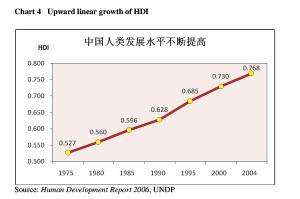Chapter 2 – China’s Economy And Enterprises ~ Part One: China’s Economy: Achievements, Challenges, And Future Orientation ~The Irish Asia Strategy and Its China Relations
No comments yet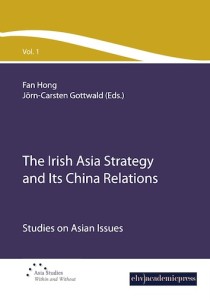 Speech at the International Forum: China in the 21st Century: Culture, Politics, and Business – Sha Hailin
Speech at the International Forum: China in the 21st Century: Culture, Politics, and Business – Sha Hailin
Part One – China’s economy: achievements, challenges, and future orientation
1. Remarkable economic achievements in China
Ever since reform and opening up, China has made remarkable achievements in economic and social developments. The economy has grown rapidly, people’s living standards have improved significantly, overall strength of the nation has been enhanced, and great progress has been made in social developments. In recent years, in particular, China has given greater priority to the quality of her economic growth and has taken a scientific approach, working towards comprehensive, harmonious, and sustainable development in the future.
1.1 High-speed growth over the past consecutive years
According to official statistics, aggregate GDP, over the past 28 years since China’s reform and opening up, rose from USD 147.3 billion in 1978 to USD 2245 billion in2005, registering a 15.2-fold growth[i]. From 1979 through 2005, the GDP of China in real terms had an average annual growth of about 9.7% (based on comparable prices). During the same period, per capita GDP grew from USD 173 in 1980 to USD 1700 in 2005, registering a 10-fold increase.
Such speed is much greater than the high growth rate once achieved by Japan and other newly industrialized economies in Asia, and has created the biggest miracle in the history of world economic development. Japan experienced an annual economic growth of 3.85% during its golden period between 1971 and 1991, and Korea, Chinese Taiwan, and Malaysia witnessed an annual economic growth of 7.06%, 7.35%, and 6.53% in their respective economies between 1971 and 2003. [ppt 7] We can proudly say, “No county can beat China in terms of long-term sustained and high growth in its economy. It has taken China only 20-odd years to achieve what took other countries several decades or even more than a hundred years.”[ii] After the newly-elected central government made a proposal to take a scientific approach towards a comprehensive, harmonious, and sustainable development, China’s economy has taken on a momentum of fast and steady growth. According to preliminary data worked out in the 2006 Statistics Gazette of the People’s Republic of China on National Economic and Social Development, China’s GDP reached RMB 20940.7 billion, up 10.7% over the previous year (See Chart 1).
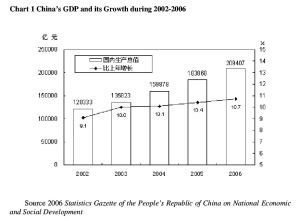
Chart 1 China’s GDP and its Growth during 2002-2006
Source: 2006 Statistics Gazette of the People’s Republic of China on National Economic and Social Development
1.2 Optimization of industrial structure
Apart from the high level of economic growth, there has been a gradual optimization of industrial structure in China. Back in 1978, the proportion of the primary industry to GDP was 28.1%, secondary industry 48.2%, and tertiary industry 23.7%. By 2005, the primary industry dropped to 12.4%, secondary industry to 47.3%, with the rise of the tertiary industry to 40.3% [iii]. According to the Statistics Gazette, the added value of the primary industry amounted to RMB 2470 billion in 2006, up 5.0%; that of the second industry was RMB 10200.4 billion, up 12.5%; that of the tertiary industry stood at RMB 8270.3 billion, up 10.3%. The three industries account for 11.8%, 48.7%, and 39.5% of GDP[iv].
1.3 Opening wider to the outside world
Ever since the basic strategy was raised at the 3rd Plenary Session of the 11th CPC Central Committee to promote economic and social development through opening up, China has been a very active player in international economic and technological cooperation and competition, and has opened further and wider to the outside world, seizing the opportunities brought by economic globalization. Especially since 2001, China’s accession to the WTO has brought the Chinese domestic market closer to the international market, and greatly enhanced the interaction between our domestic economy and the world economy. Trade and investment have become the major forces driving the economic and social development of China.
During the 10th Five-Year Period (2001-2005), especially after China’s entry into the WTO, trade and foreign investment in China increased significantly. Over the five-year period, total trade volume reached USD 4557.9 billion, with an average annual increase of 24.6%, among which exports totalled USD 2385.2 billion, with an average annual growth of 25%, and imports totalled USD 2172.7 billion, with an average annual growth of 24%. The paid-in amount of FDI was USD 274.1 billion, with an average annual growth of 8.2%. These figures show a significant increase in trade and investment over the 9th Five-Year Period (See Table 1)
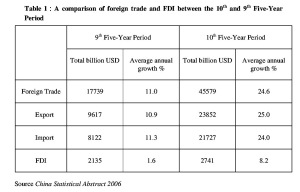
Table 1:A comparison of foreign trade and FDI between the 10th and 9th Five-Year Period
Source: China Statistical Abstract 2006
From 1978 to 2005, total trade volume rose from USD 20.6 billion to USD 1422.1 billion, registering an annual average growth over 16%. China entered a new stage of all-dimensional liberalization in her economy in 2006, following the ending of the transitional period of China’s WTO accession. In 2006, China was the third biggest trading nation in the world with total trade volume of USD 1760.7 billion, up 23.8% over 2005, among which export was USD 969.1 billion, up 27.2%, and import was USD 791.6 billion, up 20.0%. Export exceeded import by USD 177.5 billion, up USD 75.5 billion (see Chart 2).
According to the Ministry of Commerce of China (MOFCOM), there were 41473 new FDI projects (non-financial) in China in 2006, with an actual utilization of USD 63.021 billion, up 4.47% over the previous year. The aggregate utilization of foreign direct investment from 1979 to 2006 stood at USD 685.45 billion. Especially since 1991, there has been an substantial increase in FDI, securing China the No.1 position among the developing countries in attracting FDI for 16 consecutive years (See Chart 3).
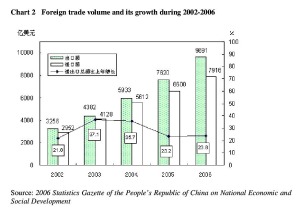
Chart 2 Foreign trade volume and its growth during 2002-2006
Source: 2006 Statistics Gazette of the People’s Republic of China on National Economic and Social Development
As a result of the open policy, China has not only promoted her own economic and social development, but also achieved mutual benefits in interaction with the rest of the world. The introduction of foreign investment has provided China with much-needed capital for her development. The interaction with the international market has pushed the development of her domestic industries. The advanced technologies, equipment, and managerial experience China has imported from outside has helped her improve the production and management of her domestic enterprises. The active exchanges with the rest of the world and sharing of the fruits of human civilization have upgraded the quality of human resources in China.
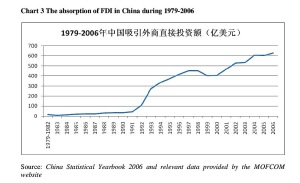
Chart 3 The absorption of FDI in China during 1979-2006 Source: China Statistical Yearbook 2006 and relevant data provided by the MOFCOM website
1.4 Deepening reform
At the same time, China has been deepening the reform to further improve the socialist market economic system. Over the past 30 years, efforts have been continuously made to reform state-owned enterprises and promote the development of foreign-invested and non-state-owned businesses so as to give full play to the potential and initiatives of businesses with various ownerships in developing the productive forces and improving the living standards of the general public. At the same time, efforts have also been made to further the reforms on the monetary system, financial system, social security system, and educational system to provide a better external environment for economic and social development. Furthermore, efforts have been made to promote the transformation of government functions with a view to building a service-oriented and rule-based government.
1.5 Outstanding achievements in social development
While securing a fast pace in economic development, China also attaches great importance to the development of social productive forces and the improvement of people’s material and spiritual well-being so as to make valuable contributions to the development of human beings and the world-wide elimination of poverty.
China has successfully fed 22% of the world’s population with less than 10% of the world’s arable land. In addition, there have been constant improvements in the life of the 1.3 billion population of China. The Chinese Government has basically lifted 220 million people out of poverty, meeting ahead of schedule the first of the UN Millennium Development Goals of halving extreme poverty, providing minimum subsistence allowance for 22.41 million urban and township residents and 15.09 million rural residents, and offering assistance to over 60million disabled people. Average life expectancy rose from 35 before the founding of the PRC to 71.9 in 2004, the same level of the medium-developed countries. The Human Development Index (HDI) level kept rising from 0.527 in 1975 to 0.768 in 2004, ranking the 81st place among 177 candidate countries and regions, and is aiming higher (k>0.8) (See Chart 4).
Over the five years from 2002 to 2006, China witnessed a steady rise in the living standards of urban and rural residents (See Charts 5 and 6). In 2006, the per capita pure income of rural people was 3587 RMB, up 7.4% in real terms, disposable income for urban and township residents was 11749 RMB, up 10.4% in real terms. The Engel Coefficient (which indicates the proportion of household food expenditure in total consumption) of rural households was 43% while that for urban and township households was 35.8%, indicating a further improvement in people’s well-being.
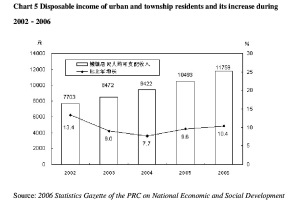
Chart 5 Disposable income of urban and township residents and its increase during 2002-2006
Source: 2006 Statistics Gazette of the PRC on National Economic and Social Development
2. Chinese development experience and challenges ahead
In my opinion, the following factors have contributed to China’s remarkable economic and social development over the recent years. They are:
First, advantages in political resources and a set of good government policies. The Chinese Government has attached great importance to the role the government should play in guiding, planning, and promoting economic and social development. During the reform and opening up process, a series of fairly scientific and suitable policy frameworks have been established, covering the economic, political, cultural, and social construction of China.
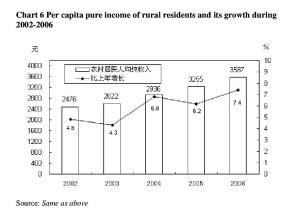
Chart 6 Per capita pure income of rural residents and its growth during 2002-2006 Source: 2006 Statistics Gazette of the PRC on National Economic and Social Development
Second, a comparatively high capital formation rate and continuous large-scale investments are the major forces and sources of continuous economic growth at high speed. Back in 1979, the domestic deposit rate in China reached 32% and it stood at 40% for a long time during the 1990s. In 2005, deposit rate was as high as 46%, which is rare in the world. Another source of high investment is FDI. Up to the end of 2006, the aggregate utilization of foreign capital reached USD 685.45 billion . China has managed to avoid the difficulties most developing nations face in getting sufficient capital and maintaining high economic growth. High investment has made possible significant infrastructure improvement, industrial structural upgrading, and technological progress.
Third, ample, quality low cost labour force is the main guarantee for China’s rapid economic growth. Since time immemorial, the Chinese nationalities are well known for their fine tradition of diligence and thriftiness and the Chinese people have created a magnificent material and spiritual civilization for China and human beings. Thanks to this China has been able to maintain her comparative advantage and strong competitiveness for a long time in labour-intensive industries since the reform and opening policy was adopted.
Fourth, system reform and institutional innovation has ensured continuous economic and social growth and progress. What is worth mentioning is that various non-state economic elements have become the major driving force for China’s economic development. Up to the end of 2005, the turnover of private enterprises and directly foreign-invested enterprises contributed to 65% of GDP, far greater than the state-owned enterprises. According to the Ministry of Commerce of China (MOFCOM), private economy is expected to create 75% of the total GDP by 2010[v].
However, we are also well aware of the in-depth conflicts/contradiction and problems China faces in developing its economy.
First, striking structural conflicts/contradictions remain in the economy. These are mainly reflected in the irrational proportions of the three industries, uneven development between urban areas and rural areas, between different regions, and inharmonious relationships between investment and consumption. Among them, the most striking ones are the oversize of investments in fixed assets, surplus liquidity of banking capital, the existence of factors triggering investment growth and loan expansion, large foreign trade surplus, and increased imbalance of international payments.
Second, the economic growth pattern remains primitive, exerting a greater strain on resources and the environment. The outstanding problems are high energy consumption and serious environmental pollution. For instance, China failed to meet the energy conservation and discharge reduction goal of reducing energy consumption per unit GDP by 4% and the discharge of pollutants by 2% in the first year of the 11th Five-Year Plan 2006, even though these standards were made compulsory under the Plan. Therefore, the task remains daunting.
Third, there is a lack of independent innovative capability, in particular, slow technological innovation and low contribution of technology to economic growth.
Fourth, the transformation of government functions can’t keep pace with economic development, leading to some problems with administrative improvement. For instance, there are still areas where government is not separated from business; some government agencies don’t have clear responsibilities; work efficiency remains low; administrative cost is high; problems of bureaucracy, formalism, abuse of power, embezzlement and corruption are found in some regions and agencies. The root cause of the above problems is the absence of a sound system and desirable supervision.
Fifth, some problems related to the interests of the general public are not well solved. There are still complaints regarding food and drug safety, medical service, educational charges, distribution of income, public order, and production safety. Other issues which hurt the interests of people are not solved completely, involving the expropriation of land/requisition land, relocation of houses, change of business ownership, and environmental protection. Quite a few low-income people live in poor conditions.
3. Future development orientation
In the years to come, China will hold up the scientific view of development, give priority to development, and try to solve problems through development and reform with economic construction as the central task. The scientific view of development is hinged on the notion that the development should be people-oriented, approached from a new perspective, in an innovative way, delivering solid results so as to lead the economy and society to a path of comprehensive, harmonious, and sustainable development.
Taking into consideration trends and conditions for development over the next five years, China is trying to achieve continuous, fast, harmonious, and healthy economic development and all-dimensional social progress during the 11th Five-year Period to make an important headway towards the building of an all-round well-off society. The main objectives include the following:
1. a 2-fold increase of per capita GDP in 2010 over that of 2000 based on optimizing structure, enhancing efficiency, and reducing consumption;
2. a significant improvement in resource utilization efficiency so that energy consumption per unit GDP drops by 20%, the trend of deterioration in ecological environment is basically checked and the acceleration in the decrease in arable land is put under effective control;
3. having a host of competitive enterprises that are equipped with intellectual property rights and famous brands developed by themselves;
4. a sound socialist market economic system with a higher degree of liberalization and balanced international payments;
5. 9-year compulsory education being popularized and consolidated;
6. increased employment in cities and towns;
7. a solid social security system;
8. a gradual decrease in poverty;
9. a general rise of income and improvement of living standards in both urban and rural areas;
10. stability in overall price levels; substantial improvement in housing, transportation, education, culture, health and environment;
11. new ground in building democratic and rule-based systems as well as spiritual civilization;
12. further improvement in public order and production safety;
13. new progress in building a harmonious society;
14. becoming a even more staunch force in safeguarding world peace and promoting common development.
To realize the above goals, China will follow the scientific view of development and vigorously work towards the building of a socialist harmonious society. China shall adhere to the course of peace and development. For the above purposes, China has the following strategic objectives and basic/ fundamental purposes:
First, maintain steady and fast economic growth. China will further expand domestic demand, adjust the relationship between investment and consumption, and control investment scale so that consumption can play a bigger role in boosting economic growth. We shall make correct judgments regarding the changes in economic development trends and maintain the general balance between supply and demand so as to avoid big economic fluctuations.
Second, accelerate the change in economic growth patterns. China shall make resource conservation a basic state policy. Through developing a recycle economy, preserving the biological environment, and building a resource saving and environmental-friendly society, China will promote the harmonious development of economy, population, resources and environment. We will push forward economic and social informatization, take a new course of industrialization, and realize sustainable development by practicing conservation and clean and safe development.
Third, enhance independent innovative capabilities. China shall implement at different levels the strategy of rejuvenating the nation through science and education relying on independent innovation to achieve scientific and technological development, economic restructuring and change of growth patterns, as well as raising generic innovative capabilities, pooling innovative talents together, and introducing and absorbing talents that are able to regenerate innovative capabilities.
Fourth, promote even development of urban and rural areas. China shall take a holistic approach and coordinate the development of urban and rural areas. Problems relating to agriculture, farmers, and the countryside should be given top priority. We shall develop a new socialist countryside by nurturing agriculture with industrial income and supporting the rural areas by the urban areas so as to secure a healthy development in urbanization. We need to put in place an overall development strategy and form a harmonious development mechanism where there is complementarily between the eastern, middle and western parts of China and good interaction among the regions.
Fifth, enhance the construction of a socialist harmonious society. China shall take a people-oriented approach, solve the problems that bear on the interests of the general public, attach greater importance to harmonious economic and social development, try every means to create jobs, accelerate the development of social undertakings, and promote the overall development of people. We will attach importance to social fairness so that all people can share the results of development and reform. We will make greater efforts to build a democratic and rule-based system, correctly deal with the relationship between reform, development, and stability, and maintain social stability and unity.
Sixth, continue the deepening of reform and opening up. China shall stick to the direction of building a socialist market economy while conducting various reforms. Modern enterprise systems and ownership systems shall be further improved. A rational price formation mechanism needs to be established to fully reflect the relationship of supply and demand and the scarcity of resources so as to let the market play a fundamental role in the efficient allocation of resources. We shall transform the government functions and improve the state macro-control system. In the meantime, we shall also balance internal development and opening up so that the development will be greatly enhanced by opening wide to the outside world.
Seventh, unswervingly follow the path of peace and development. Peace, development and cooperation are the themes of our times. China can’t develop without the rest of the world, and vice-versa. Ever since reform and opening up in the 1970s, China has been successfully walking along the path of peace and development that is in line with the conditions of the country and the trend of our times. China will unswervingly follow that path and work towards the building of a modern, prosperous, democratic, civilized, and harmonious country, which will make greater contributions to the progress of mankind. To achieve this end, we need to adhere to the notion of peace, opening, cooperation, harmony, and mutual benefit, under which we shall balance internal development with opening up, link China’s development with the development of the rest of the world, and associate the fundamental interests of the Chinese people with those of the people in the rest of the world. We believe a harmonious internal environment and a peaceful external environment constitute a closely related entity, which is good for the establishment of a harmonious world with lasting peace and common prosperity.
NOTES
[i] 1978 data was cited from the speech made by President Hu Jintao at the opening ceremony of Fortune Global Forum 2005 in Beijing, 2005 Data refers to the State Bureau of Statistics of China.
[ii] Mathew Shane and Fred Gale:China: A Study of Dynamic Growth – Outlook Report No. (WRS0408) 20 pp, October 2004,http://www.ers.usda.gov
[iii] 2005 Statistics Gazette of the People’s Republic of China on National Economic and Social Development, dated February 28, 2006
[iv] 2006 Statistics Gazette of the People’s Republic of China on National Economic and Social Development, dated February 27, 2007
[v] “Ministry of Commerce: Four Years Later, 2/3 of China’s GDP will be Contributed by Provate Economy.’ China New Network, November 12, 2006.
You May Also Like
Comments
Leave a Reply
